Gregory A. Fournier's Blog, page 51
September 1, 2012
John Norman Collins' Nemesis - Washtenaw County Sheriff Douglas J. Harvey - Part One
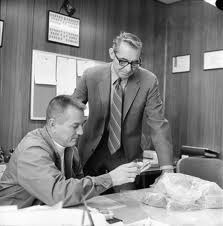 Sheriff Doug Harvey seated with detective.The most controversial figure in the John Norman Collins' case, other than the defendant himself, was former Washtenaw County Sheriff, Douglas J. Harvey.
Sheriff Doug Harvey seated with detective.The most controversial figure in the John Norman Collins' case, other than the defendant himself, was former Washtenaw County Sheriff, Douglas J. Harvey.Repeatedly during the pretrial hearings and the trial itself, the defense team attempted to undermine the credibility of the sheriff, the highest ranking police officer in the county.
Joseph Louisell, sometime Detroit Mafia lawyer, and his junior partner, Neil Fink, wasted no opportunity to scrutinize and criticize Harvey's every move openly in the courtroom and afterwards with the press.
Prospective jurors were asked during the jury selection process if they would give more weight to something Sheriff Harvey testified to just because he was the sheriff. Even more pointed were questions like, "Do you think Sheriff Harvey would misrepresent the truth?" Louisell would say while standing behind Collins with his hands resting on his client's shoulders. The defense was doing their damnedest to shift attention away from their client and onto overzealous law enforcement in the guise of the sheriff.
Douglas J. Harvey first came to public notice as a public figure after winning an upset victory over his old boss. He was a thirty-two year old Democrat who was sworn in on January 1, 1965, the second youngest man ever to hold the office of county sheriff in Washtenaw county, a county that hadn't elected a Democrat for sheriff in forty years.
Harvey's relative lack of experience for the position was offset by his popularity on the local stock car racing circuit. Originally sponsored by a service station owner, Harvey won over 100 races. He would keep the trophies and his sponsor would get the prize money to put back into the cars. I say "cars" because Harvey has demolished eight cars. He was a fan favorite which helped him defeat his former boss.
Before "The Battle of Ann Arbor" street riots and the "Co-ed Killings" of the late sixties, Sheriff Harvey and his department made the news with a less harrowing human interest story, "The Great Michigan UFO Chase." It was widely reported that on March 17, 1966, Sheriff Harvey ordered all available squad cars to the scene of a UFO sighting in Dexter, Michigan. Officers gave chase down Island Lake Rd. See the link for more details.
http://www.ufocasebook.com/michigan1966chase.html
(Sheriff Harvey - To be continued...)
Published on September 01, 2012 17:20
August 24, 2012
20th Anniversary of Birch Aquarium at Scripps Institution of Oceanography, UC San Diego
 September 16, 2012, marks the 20th anniversary of the Birch Aquarium at Scripps. When it opened in 1992, it was three times larger than its predecessor, Scripps Aquarium, which operated for forty-one years next to the Scripps Pier since 1903.
September 16, 2012, marks the 20th anniversary of the Birch Aquarium at Scripps. When it opened in 1992, it was three times larger than its predecessor, Scripps Aquarium, which operated for forty-one years next to the Scripps Pier since 1903.The mission of Birch Aquarium at Scripps is to provide ocean science education, to interpret Scripps Institution of Oceanography research, and to promote ocean conservation.
Nestled comfortably between the University of California and the Scripps Institution of Oceanography, Birch Aquarium overlooks the famous Scripps Pier and La Jolla Shores to the south and Del Mar to the north.
My granddaughter and I spend an enjoyable afternoon there yesterday. Besides learning about the local sea life off our Pacific Coast from the Northwest to Baja, there are hands-on exhibits on energy conservation, climate change, and innovative energy resources that were quite interesting.
The most striking feature of this aquatic science complex is the huge floor to ceiling Kelp Forest Tank which houses many species of local marine life, weaving in and out of amber forests of kelp. The Kelp beds, off the Southern Californian coast, provide shelter and habitat for hundreds of species of marine life as this massive tank demonstrates.
What seems to be the most popular attraction for everyone at Birch is Tide-Pool Plaza. Many life forms found in tidal pools along our San Diego coastline are concentrated in an accessible, hands-on, outdoors exhibit built on a deck that overlooks the grandeur of the Pacific Ocean.
If you find yourself in the San Diego area, this is an affordable and lovely way to spend an afternoon. For more information, check the link:
aquarium.ucsd.edu
Published on August 24, 2012 09:41
August 17, 2012
The Handicapable Car - The Kenguru
 Wheelchair, be damned!
Wheelchair, be damned!Here is a product that gives movement and freedom to people who need it the most - the handicapable among us!
The engineers and the research and development teams must be proud of their work.
Check these pictures out: http://www.kengurucars.com/
Published on August 17, 2012 08:24
August 16, 2012
Zug Island Author, Gregory A. Fournier, Recognized by Worldwide Who's Who

My debut, award winning novel is available at Amazon and in the Kindle ebook format: http://www.amazon.com/Zug-Island-Detroit-Riot-Novel/dp/1604945850
Published on August 16, 2012 00:00
August 11, 2012
Eastern Michigan University "72-73" Campus Directory - The John Norman Collins' Edition.
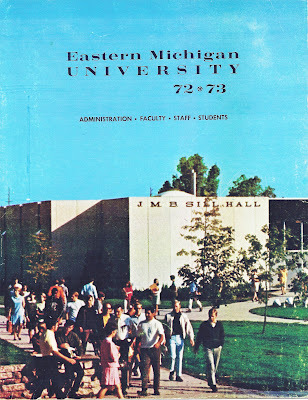 Back in 1972, the student population of Eastern Michigan University was decidedly non-Ivy League in their attitudes and their dress code.
Back in 1972, the student population of Eastern Michigan University was decidedly non-Ivy League in their attitudes and their dress code.Wanting to maintain a conservative image for the alumnae and parents of students at the university, editors for the campus phone directory chose to dip into their photo archives for a picture from 1966.
Ground was broken on Sill Hall, the Fine Arts building, in 1964, and it was open for the fall semester of 1966. Not only do the clothes and hair styles date the photograph, but the fresh sod and the sapling trees do as well.
I remember this directory and used it many times, as I graduated with a bachelor's degree in December of 1972. What makes this telephone book relic relevant to me now is what I discovered only last year.
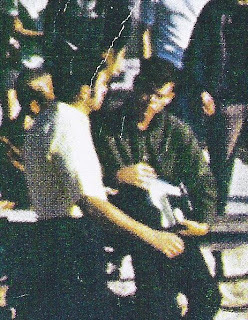 The university made a grievous error in their choice for a cover photo. Sitting on the wall with the dark shirt in the lower left hand corner of the cover shot sits alleged serial killer, John Norman Collins. He was convicted in 1970 of just one of seven possible murders of young women in the area he was suspected of killing between the summers of 1967 and 1969.
The university made a grievous error in their choice for a cover photo. Sitting on the wall with the dark shirt in the lower left hand corner of the cover shot sits alleged serial killer, John Norman Collins. He was convicted in 1970 of just one of seven possible murders of young women in the area he was suspected of killing between the summers of 1967 and 1969.Looking at the full sized actual cover of the directory, the photograph is unmistakable to anyone who knew John Collins. In 1966, Collins was beginning his first year at Eastern as a sophomore transfer student from Central Michigan University.
This photograph was taken ten months before the murder of the first victim took place. Mary Fleszar's ravaged body was left to rot in the countryside, found a month later by two thirteen year old boys. Her murder remains officially unsolved.
The university denies this is Collins, but they can't identify who it is. I lived a block up the street from John Norman Collins and saw him numerous times. That's him!
Published on August 11, 2012 16:45
August 6, 2012
Kirkus Indie Review of Zug Island: A Detroit Riot Novel
 ZUG ISLAND A Detroit Riot Novel By Gregory A. Fournier Pub Date: June 15th, 2011
ZUG ISLAND A Detroit Riot Novel By Gregory A. Fournier Pub Date: June 15th, 2011ISBN: 978-1604945850
Publisher: Wheatmark
In Fournier’s thoughtful debut novel, a young man comes of age in the tense atmosphere of a city teetering on the edge of chaos.
Jake Malone, a white college kid in suburban Detroit in 1967, gets kicked out of school and decides to earn a little money to get a car of his own. He ends up at Zug Island, a steelworking plant that’s a world away from his suburban home. When he first sees the place, it reminds Jake of Dante’s Inferno, but he doesn’t know yet how literal that perception will become. After a tense fight at the plant, he’s befriended by Theo Semple, an African-American man who came to Detroit for better wages but left a family and a tragic history back in the South. In their spare time, Jake and Theo hit the town seeking adventures. As the story unfolds, what they find is eye-opening for Jake—from prostitution and police brutality on the streets of Detroit to the casual racism found in the all-white suburbs. The racial tension builds, until one day it explodes in riots that turn Detroit into an inferno. Told from Jake’s perspective, the short novel—part journey through hell, part social document, part adventure story—depicts his struggles with race and class pressure. Fournier reveals what life was like not only on Zug Island, but also on the streets of Detroit, in its white suburbs and in white and black churches. Readers may wish the author had spent more time in some of the scenes, particularly the riots, which are described from a distance. The Vietnam War is mentioned, but its impact is left unexplored. Also, at times, Fournier steps back from the story to fill in general history that is illuminating, even though it breaks the narrative flow. On the whole, however, the novel is tightly written with a dramatic plot, well-rounded characters and clear insights into social history.
An engaging, dynamic story that grapples intelligently with themes of race, class and morality.
Available at Amazon.com and in the Kindle e-book format.
Published on August 06, 2012 12:38
August 3, 2012
Quick Party Caricatures by Walt Griggs
 While doing research for my next book, In the Shadow of the Water Tower, in Ypsilanti, Michigan, I ran into Walt Griggs, a caricature artist preparing to set up for a party he was working at The Corner Brewery.
While doing research for my next book, In the Shadow of the Water Tower, in Ypsilanti, Michigan, I ran into Walt Griggs, a caricature artist preparing to set up for a party he was working at The Corner Brewery.I struck up a conversations with him about my reason for being in town and he was quite intrigued. He had never heard of John Norman Collins or the coed killings.
"Would you like me to draw you? I need to warm up." The party hadn't started quite yet.
"Sure," I said. "Do you want me to pose or anything?"
"No. Just sit there and tell me more about your book."
Five minutes later, he handed me the drawing you see above. I was really pleased with it, though I don't think I'm that gleeful in real life. Of course, that's why it's called a caricature.
What a great idea! Hiring someone to caricature quests at a party. The artist gets a commission for being there, and he earns tips and future referrals for other jobs at the same time.
As people began to arrive at the private party, I traded him a copy of Zug Island and thanked him. We both made a good deal I think.
Check out Walt's website at: www.artistrising.com/galleries/waltgriggs
Published on August 03, 2012 08:53
July 31, 2012
Fraud Alert! Beware of Wireless Chip in Your Credit Card
 Cyber criminals have a powerful ally - the credit card companies themselves. Credit card fraud has never been easier.
Cyber criminals have a powerful ally - the credit card companies themselves. Credit card fraud has never been easier.Because of a wireless chip in millions of credit cards, your "secure" number can be lifted from your purse, pocket, or wallet without even touching you. All a criminal needs is a card reader and an i-Pad.
You don't believe me? Check out the link below.
http://youtube.googleapis.com/v/lLAFhTjsQHw%26sns=em
Published on July 31, 2012 07:15
July 25, 2012
Redezvous with Death - Part Four
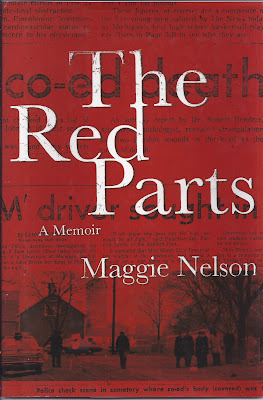 In her profoundly personal memoir, The Red Parts, Maggie Nelson has given readers a glimpse of what lies behind the curtain of American jurisprudence and its affect on the surviving members of one family. Miss Nelson is the niece of Jane Mixer, John Norman Collins' alleged third victim.
In her profoundly personal memoir, The Red Parts, Maggie Nelson has given readers a glimpse of what lies behind the curtain of American jurisprudence and its affect on the surviving members of one family. Miss Nelson is the niece of Jane Mixer, John Norman Collins' alleged third victim.Thirty-six years after Jane's perplexing murder on March 20, 1969, the Mixer family had to endure testimony of the details of her tragic death in a trial held in Wayne County, Michigan in 2004. For over three decades, Jane's murder was lumped together with the five other unsolved killings in the Ypsilanti/Ann Arbor area, despite fundamental differences including where, how, and what condition the body was found.
Armed with a positive DNA match, as well as convincing circumstantial evidence, Gary Earl Leiterman, a retired male nurse working in Ann Arbor at the time, was found guilt of her murder. John Norman Collins claimed since the beginning that he never knew Jane, now he was exonerated for at least one of the seven Michigan murders he was accused of. Even a broken clock is right twice a day.
With unflinching honesty, Miss Nelson tells us the ins-and-outs of her aunt's case with brutal clarity and a benumbing sense of self-awareness that only comes from profound emotional trauma. Early in her book, she asks herself, "Who am I to tell Jane's story?" I can think of nobody better. Later in the book, she finds herself getting drawn into the media vortex of the trial and its aftermath. She has some insightful things to say about American media's fascination with the "dead-white-girl-of-the-week" club.
After reading Maggie Nelson's memoir, I am reminded that disturbing the feelings and memories of the families of the other victims in the Collins case are not to be taken lightly. These girls deserve to be remembered as living human beings, rather than victims of something wicked that happened in another time no longer relevant today. For their memories and what happened to them to simply fade away is unacceptable.
This is Ypsilanti, Michigan history, however unpleasant for individuals or for the city. The six other murdered girls deserve to have their stories told for the record as well, like Jane Mixer did for the memory of her aunt. I want to honor those lost innocents by relating the most accurate account of these matters as possible and bringing some degree of closure to people who cared about these young women. In the end, the public needs the truth.
Published on July 25, 2012 00:00
July 21, 2012
Rendezvous with Death - Part Three
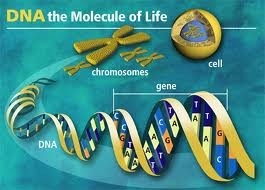
Since the 1980s, law enforcement experienced a gradual decline in the number of violent crimes in the United States. In 2003, the U.S. House of Representatives authorized one billion dollars to use DNA to reduce the huge backlog of cases that had gone cold. Two retired Michigan State Police Detectives volunteered to look into the Michigan Coed murders of the late 1960s.
In 2004, the Michigan State Police ran DNA samples from at least two of the murdered Michigan coeds through the FBIs Combined DNA Index System (CODIS). The third young woman John Norman Collins allegedly killed in the series of seven sex slayings attributed to him was twenty-three year old, Jane Mixer, a graduate law student at The University of Michigan.
Even though a few investigators most familiar with these cases felt from the start that Jane's murder was characteristically different from the two previous murders, she was included in the unsolved coed murder cache. Thirty-five years later, a DNA analysis of her pantyhose revealed copious amounts of perspiration on them that wasn't from Jane. DNA was extracted from the sweat cells and run through the FBI's CODIS database.
 The first run through the system produced a "cold" hit on a retired male nurse who had been convicted on a prior fraud charge for writing bogus prescriptions. He was entered into the CODIS system at that time. Gary Earl Leiterman, dubbed by the local press as "The Elmer Fudd Killer," was found guilty of the murder of Jane Mixer. John Norman Collins was cleared.
The first run through the system produced a "cold" hit on a retired male nurse who had been convicted on a prior fraud charge for writing bogus prescriptions. He was entered into the CODIS system at that time. Gary Earl Leiterman, dubbed by the local press as "The Elmer Fudd Killer," was found guilty of the murder of Jane Mixer. John Norman Collins was cleared.Since DNA scientific evidence is considered so strong in court, many cold cases have been solved in the thirty years since it has been introduced as an effective crime fighting tool. Many guilty parties have been brought to justice, while some of the innocent have been exonerated of their crimes after years of unjust imprisonment.
It should be noted that John Norman Collins has refused DNA testing, which could prove him innocent of the murders he has steadfastly claimed he is innocent of committing for the last forty-five years. Even John's supporters must find that curious. Seems to me if he had a "Get Out of Jail" card, he would have gotten his ticket punched years ago.
(To be continued...)
http://www.murderpedia.org/male.L/l/leiterman-gary-photos.htm
Published on July 21, 2012 00:00



